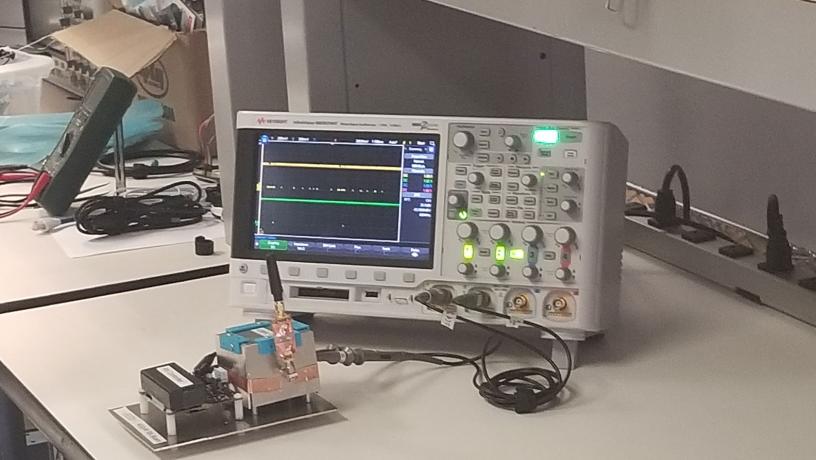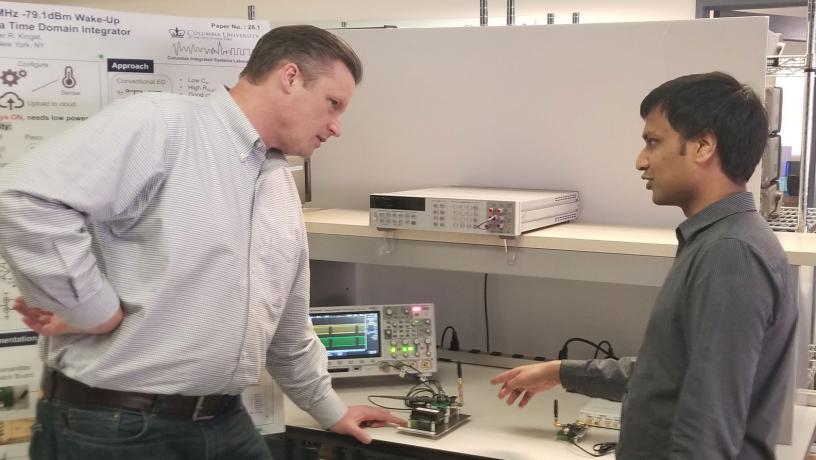Always on Call
This wake-up receiver can run for decades on the energy in a few grains of sugar

The tiny ultra-low power wake-up receiver operates at 420 picowatts or under a billionth of an iPhone’s energy consumption.
For years now, the internet of things has hovered just over the horizon. Once implemented, its possibilities may be limitless, but implementation on a wide scale is unlikely until researchers can resolve a central conundrum: how to efficiently power the millions of sensors needed to reshape our world into a dynamically-adjusting, context-driven environment.
That’s where “wake-up” receivers come in. A particularly promising strategy, these tiny devices listen constantly for a unique radio frequency (RF) signature, which only then in turn triggers the activation of more power-hungry systems. Columbia engineers have developed such a device that can run for years or decades on the energy of just a few grains of sugar—making it the most efficient wake-up receiver yet designed.
Their tiny ultra-low-power component circuit operates at 420 picowatts or under a billionth of an iPhone’s energy consumption. “Ours is the least power-consuming receiver we know of, about ten times better than any that existed before,” said Vivek Mangal, a member of Electrical Engineering Professor Peter Kinget’s Analog and RF Design Research Group in the Columbia Integrated Systems Laboratory. “It’s also the most sensitive for picking up signals at small form-factor.”
In fact, a big part of the challenge of operating on the picowatt scale is that even miniscule amounts of interference can become a major problem. Mangal devised a novel receiver architecture that minimizes the added noise from the receiver while maximizing sensitivity at 434MHz without eating up more energy. He presented his work to broad acclaim at the 2019 International Solid-State Circuits Conference (ISSCC) in San Francisco.
“For a PhD student to present a paper at the ISSCC is like an athlete competing in the Olympics,” Kinget said. “Vivek introduced a lot of unique innovations in how to architect the receiver and how to design the circuits to achieve these best-in-class results.”
For a PhD student to present a paper at the ISSCC is like an athlete competing in the Olympics.

Vivek Mangal (right) is a PhD candidate in the Analog and RF Design Research Group run by Professor Peter Kinget (left), who heads the Columbia Integrated Systems Laboratory at Columbia Engineering.
At the conference, Mangal discussed new applications his innovation could enable, including the possibility of integrating these low-power techniques into very low-power biomedical implants. Currently he is working on further miniaturizing the prototype by operating at even higher frequencies. The smaller and more efficient Mangal can make wake-up receivers, the more practical it becomes to deploy them in sensors and other networked devices that can last indefinitely, without battery replacements. That would allow the technology to be embedded in hard-to-reach places where no power line is available, such as inside infrastructure, clothing, and even living organisms.
“I want to contribute as much as I can to healthcare,” he said. “There’s currently a lot of interest in wireless implants for that sector, and opportunities for interdisciplinary collaboration.”
To further add to the concept, Mangal has also developed a clockless continuous-time analog correlator that rejects unrecognized wake-up calls and enables simultaneous function of multiple receivers using different wake-up signatures. He will present this work at the Radio Frequency Integrated Circuits (RFIC) Symposium in June.
A graduate of the Indian Institute of Technology Delhi, Mangal came to Columbia in 2015 to work with Kinget on developing ultra-low-power transceivers for such applications. He will defend his PhD this spring.
